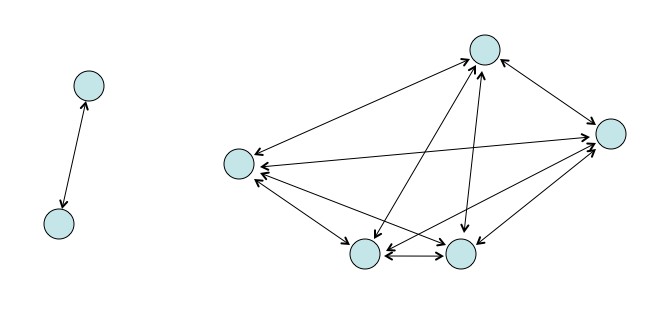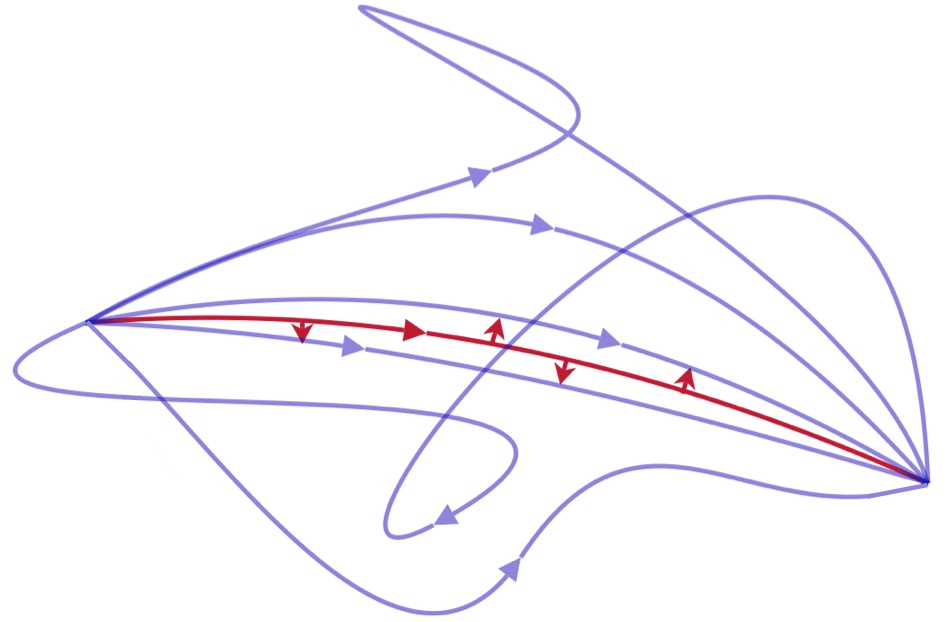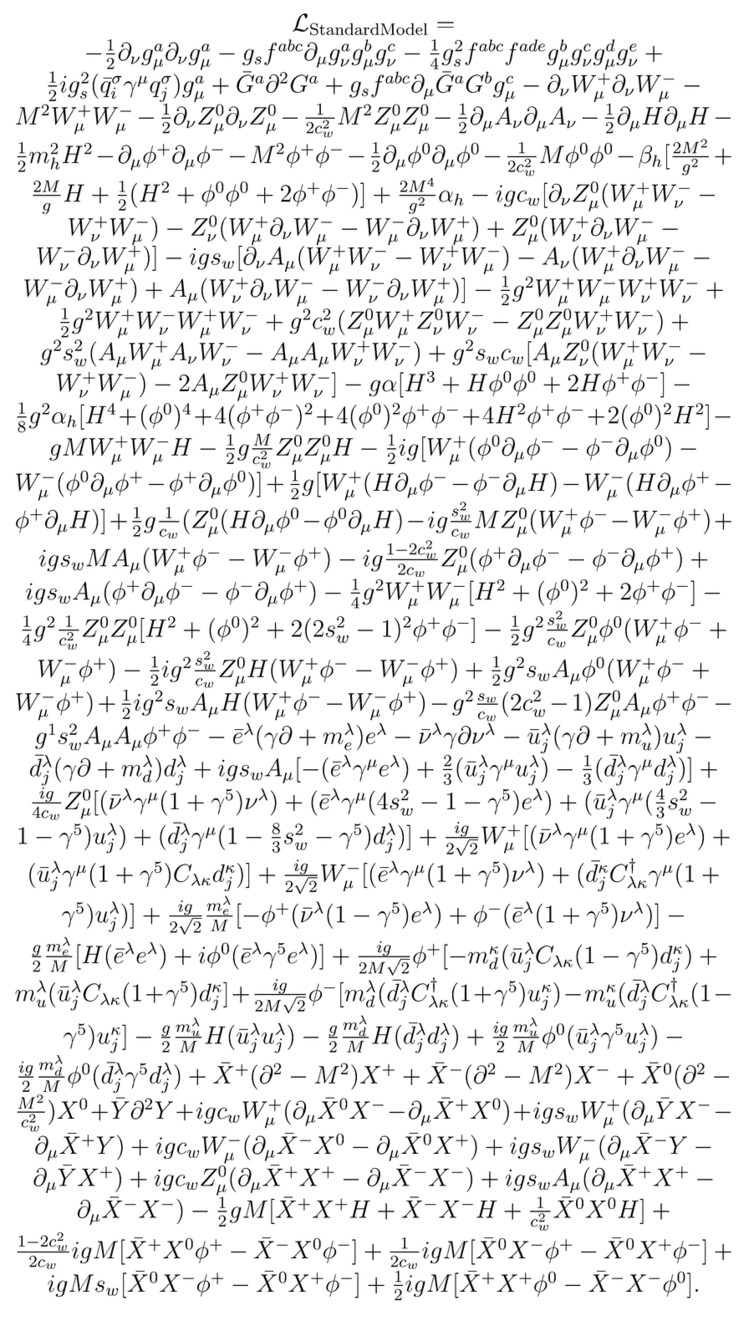Physicist: If you have plenty of chalkboard space and absolutely nothing better to do, you can write down numbers, letters (Greek if you’re δυσάρεστος), and mathematical operators and eventually you’ll have the longest equation ever written down. So if you really want to see the most complicated equation ever, call in sick for a few weeks. A better question might be “what is the most (but not needlessly) complicated equation?”.
There are plenty of equations that are infinitely long, but often they’re simple enough that we can write them compactly. For example, This equation goes on forever, but it’s fairly straight forward: every term you flip the sign and increase the denominator from one odd number to the next. You can write it in mathspeak as
. Like π itself, this sum goes on forever, but it isn’t complicated. You can describe it simply and in such a way that anyone (with sufficient time and chalk) can find as many digits of π as they like. This is the basic idea behind “Kolmogorov Complexity“; the length of the shortest possible set of written instructions that can produce a given result (never mind how long it takes to actually compute it).
If you’re looking for an equation that needs to be complicated, a good place to look is physics (I mean, what else do you really need math for?). If you want to describe the behavior of a ball flying through the air it’s not enough to say “it goes up then down”; there’s a minimum amount of math that goes into accurately calculating the path of falling objects, and it’s more complicated than that.
Arguably, the universe is pretty complicated. But like π, it is deceptively so (we hope). If you want to do something like, say, describe the gravitational interactions of every star in the galaxy, you’d do it by numbering the stars (take your time: star 1, star 2, …, star n), determine the position and mass of each, and
, and then find the force on each star produced by all the others. In practice this is absurd (there are a few hundred billion stars in the Milky Way, but we can’t see most of them because there’s a galaxy in the way), but the equation you would use is pretty straight forward. The force on star k is:
. This is just Newton’s law of gravitation,
, repeated for every possible pair of stars and added up. So while the situation itself is complicated, the equation describing it isn’t. Evidently, if you want an equation that genuinely needs to be complicated, you don’t need a complicated situation, you need complicated dynamics.

The equation for the gravity between many objects is just the equation for the gravity between every pair added up. Not much more complicated.
The whole point of physics, aside from understanding things, is to describe the rules of the universe as simply as possible. To that end, physicists love to talk about “Lagrangians”. Once you’ve got the Lagrangian of a system, you can describe the behavior of that system by applying the “principle of least action“, which says that the behavior of a system (the orbit a planet takes, the path of light through materials, etc.) will always be such that the “chosen” path will have the minimum total Lagrangian along that path. It’s a cute recipe for succinctly and simultaneously describing a lot of dynamics that would make Kolmogorov proud.

The Lagrangian gives every point on this picture a value and the total along an entire path is the “action”. The principle of least action says that the path a system will actually take has the least action. With this principle, a single Lagrangian can be used to derive many physical laws at once, so it’s a good candidate for equations that aren’t needlessly complex.
For example, you can sum up Newton’s physics almost instantly. Rather than talking about kinetic energy and momentum and falling, you can just say “Dudes and dudettes, if I may, the Lagrangian for an object flying through the air near the surface of the Earth is , where m is mass, v is velocity, and z is height”. From this single formula, you get the conservation of energy, conservation of momentum (when moving sideways), as well as the acceleration due to gravity. There are also Lagrangians for everything from orbiting planets to electromagnetic fields.
Generally, when you look at the same dynamics applied over and over, the equations involved don’t get much more complicated (although their solutions definitely do). And if you want to describe the dynamics of a system, Lagrangians are an extremely compact way to do it. So what’s the most (but not needlessly) complicated equation in the universe? Arguably, it’s the Standard Model Lagrangian, which covers the dynamics of every kind of particle and all of their interactions. Notably, it doesn’t cover gravity, but be cool. It’s a work in progress.
In some sense this equation is compressed data. All the relevant dynamics are there, but there’s a lot of unpacking to do before that becomes remotely obvious. All equations must have some context before they do anything or even mean anything. That’s why math books are mostly words. “2+2=4” means nothing to an alien until after you tell them what each of those symbols mean and how they’re being used. In the case of the Standard Model Lagrangian, each of these symbols mean a lot, the equation itself is uses cute short hand tricks, and it doesn’t even describe dynamics on its own without tying in the Principle of Least Action. But given all that, it’s describing the most complicated thing we can describe, which is nearly everything, without being needlessly verbose (“mathbose”?) about it.
Answer Gravy: This isn’t part of the question, but if you’ve taken intro physics, you’ve probably seen the equations for kinetic energy, momentum, and acceleration in a uniform gravitational field (like the one you’re experiencing right now). But unless you’re actually a physicist, you’ve probably never been freaked out by seeing a Lagrangian work. This gravy is full of calculus and intro physics.
The “action”, , is a function of the path a system takes,
. More specifically, it’s the integral of the Lagrangian between any two given times:
where t1 and t2 are the start and stop times, is a path,
is the time derivative (velocity) of that path, and
is some given function of
and
. If you want to chose a path that extremizes (either minimizes or maximizes) S, then you can do it by solving the Euler-Lagrange equations:
This is called the Euler-Lagrange equations (plural) because this is actually several equations. Each different variable (x1=x, x2=y, x3=z) tells you something different. In regular ol’ calculus, if you want to find the value of x that extremizes a function f(x), you solve for the value x. Using the Euler-Lagrange equations is philosophically similar: to find the path that extremizes S, you solve
for the path
.
The Lagrangian from earlier, for a free-falling object near the surface of the Earth, is:
For z:
So the E-L equation says:
or
In other words, “everything accelerates downward at the same rate”. Doing the same thing for x or y, you get , which says “things don’t accelerate sideways”. Both good things to know.
You wanna be even slicker, note that this Lagrangian is independent of time. That means that . Therefore, applying the chain rule:
But we have the E-L equations! Plugging those in:
And therefore:
This thing in the parentheses is constant (since it never changes in time). In the case of we find that this constant thing is:
Astute students of physics 1 will recognize the sum of kinetic energy plus gravitational potential. In other words: this is a derivation of the conservation of energy for free-falling objects. A more general treatment can be done using Noether’s Theorem, which says that every symmetry produces a conserved quantity. For example, a time symmetry ( doesn’t change in time) leads to conservation of energy and a space symmetry (
doesn’t change in some direction) leads to conservation of momentum in that direction.








MY BWAIN!!!
eknasjdfnj who came up with those words
This site is for gay ppeople and you bozo have to suck my glizzy very hard nerds lolololllll
Soon gay e richione succhiatemelo forte siete dei nerd succhiatemi le palle sono gay
I know feel like a starfish
Why; “Woman” of course, dear chap!
COME ON GUYS IS IT THAT HARD
COME ON GUYS IS IT THAT HARD —
the standerd model. its just a combo of negatives, fractions, eta, W, s^2, G-force, 1/2 M^2, and some other easy math. how hard can it be?
i just came
of course its not hard for the asian
wtf is going on with this comment section?
gvery easssdy
4th grade math
I ate smegma
Me too
What is chat its dumb
Oh I’m the one who said What is chat its dumb now I have a name lol
Hi ima IDOIT
ANYONE PLAYS SPRUNKI PLAY IT IODITS
Bro who is Ducks his his in suhs by sub an sub sub who signs in sub subway an sub sub its its his its his his his his is his his menus his make his insane one one h sjis ihs in sin Shi sin is s dungeon behind in main one behind inch to onoma mou einai tzoi NOW THATS A DUCKING LONG NAME
Hi ima mother fucker and y’all are mother fuckers
IM PLACEING BLOCKS AND SHIT CUZ ITS FUCKING MINECRAFT
ABADABAMISTICO
Guys let me tell you n inspirational quote that my friend sigma told me. When times get hard, you must get harder. Hope this helps some of you out there who are struggling with mental issues. Stay Sigma!
Oh my days skibidy smegma that’s such an inspirational quote that just made my day. Keep it kekw!!!
Bro wtf is ts..
you wot m8
Jimmy calm down
MY NAME IS ALEXaNDER K. I LIVE IN NORTH WOOD WESLEY CHAPEL FL GO TO JLMS MIDDLE SCHOOL IM 13 RUSSiAN AND PRO AT ROBLOX
MY NAME IS Ducks his his in suhs by sub an sub sub who signs in sub subway an sub sub its its his its his his his his is his his menus his make his insane one one h sjis ihs in sin Shi sin is s dungeon behind in main one behind inch to onoma mou einai tzoi
I have a 156 day Minecraft survival world this is a explanation of it
OWACKX😋 rainbow trud🌈💩 1.22 added BEANS🍛 I kill nonegsistend ender dragon🐉 moai+dioti+GYAT=MOGYATI🗿🍑😜 meower gave me rotten flesh and rabbit hide🐱 dawgy is a dawg🐺 clickerd and billard🐔🐔 RAINBOW SHEEP🌈🐑_|_=ZUZAWAZEZAWA -\_/-=BRT big sniffer👃👃👃 joeylovesflag tinkerbell1519 xxBEAST-MODEx8
Im Ducks his his in suhs by sub an sub sub who signs in sub subway an sub sub its its his its his his his his is his his menus his make his insane one one h sjis ihs in sin Shi sin is s dungeon behind in main one behind inch to onoma mou einai tzoi
Its a prank lol
Rabbit hole💩💩💩
Hey, check out this wild stuff I found! There’s a rainbow turd, some beans, and I even killed an imaginary ender dragon. My cat gave me some rotten flesh and rabbit hide, but my dog is still just a dog. I saw some clickerd and billard chickens, and a rainbow sheep that looks like ZUZAWAZEZAWA. And get this – there’s a big sniffer, a flag lover, and a beast mode person. Crazy stuff, right? IS FUCKN AMAZING
YO
my wife walks right by me and didn’t see my hardcore mincaft world because I swicht right to this thank you I sent you 100k to yor house now send 10k back for tax if you don’t you will be found buddy
Bro what is this comment section some has long ass name someone plays minecraft sprunki and Roblox like wtf is going on and why is this joey guy commenting regularly this is supposed to be for study right?
Jimmy Cai is inspirational!!!!!
worm
YALL RELAIZE THIS EQUATION IS JS SOME MF FINDING EVERY DAMN EQUATION OU THERE (BESIDES GRAVITY IDEK Y) AND PUTTING IT TOGETHER. BRO ANUONE COULD DO THAT. NOT HARD!!!!!!!!!!!!!!! JS TIME CONSUMING
GOTTA HOP BVACK ON FORT. MANGO OUT!!!
Alright! Imagine you have a very, very big puzzle. But instead of puzzle pieces, you have numbers, letters, and strange symbols. Some puzzles are easy, like putting together a picture of a cat. Some puzzles are super hard, like a giant picture of a whole city with thousands of tiny pieces.
The “most complicated equation” is like the hardest puzzle ever made with math. It has so many pieces (numbers and symbols) that even the smartest people in the world need years to understand it.
One of the hardest ones is called the Navier-Stokes equation. Imagine you’re playing in water—maybe splashing in a bathtub or watching waves in the ocean. This equation tries to predict how water and air move. But because water can swirl and twist in crazy ways, this equation is super hard to solve!
There are also other super tricky equations, like the Standard Model of Particle Physics, which is like a giant recipe telling us how tiny things (like atoms and electrons) work.
So, the hardest equation is just like the biggest, most confusing puzzle in the world, and even grown-up math experts struggle to solve it!
i see nude people
joseph stalin is eating out my bussy rn